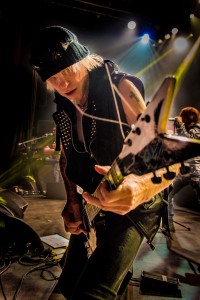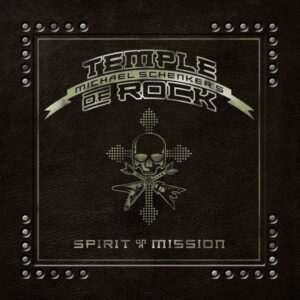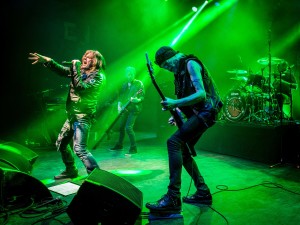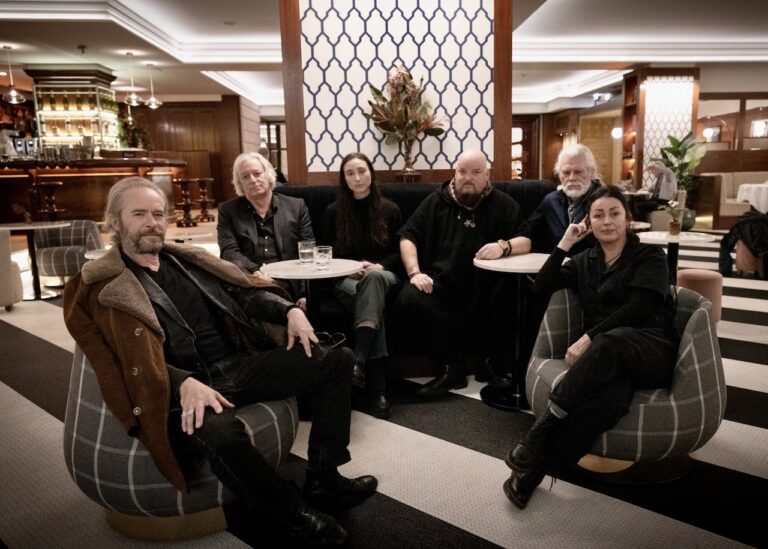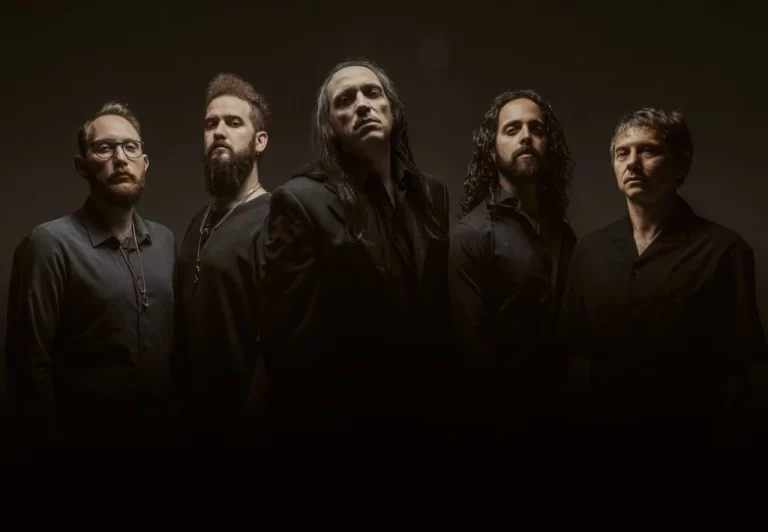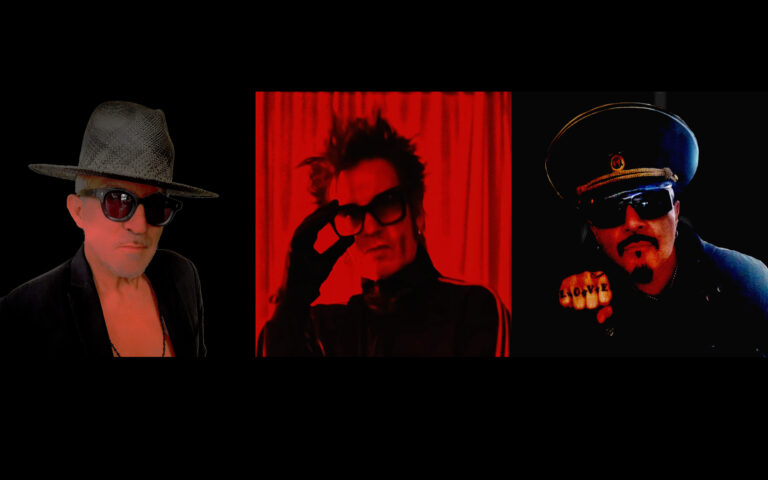For hard rock fans there are a few names which invariably come instantly to mind when you talk about world class guitarists – Jimmy Page, Jimi Hendrix, David Gilmour and, of course, Michael Schenker. Born in 1955, the guitarist has contributed his unique and distinctive playing style to UFO, the Scorpions and his own Michael Shcenker Group and, more recently, Temple of Rock. Regularly receiving awards for his innovative guitar work, Michael is an interesting figure because he rarely listens to music himself, preferring to create rather than absorb, and, as a result, much of his music has a timeless, hard-rock quality whilst his peers so often resorted to following the fashion of the day. His recent work, in particular, stands proudly above his laudable back catalogue, and his latest album in particular, ‘spirit on a mission’ is an urgent, vital slab of hard rock that quite simply wipes the floor with the competition. With Michael working alongside Doogie White, Wayne Findlay and former Scorpions, Francis Buccholz and Herman Rearebell, Temple of Rock is manna from heaven for those who like their music loud, passionate and full of heart. I was lucky enough to get Michael on the phone to talk about his latest album, his newfound love of playing live and the philosophy behind his art.
To kick off, the first time I became aware of Temple of Rock was with your live DVD, which was amazing, and what I’d like to start with is if you could talk a little bit about the inspiration behind the Temple of Rock project?
Well, it’s like this. It actually goes as far back as 2009/2008 when I was doing ‘in the midst of beauty’ with Gary Bardon, which was my reunion album with Gary, that was the time when I had the urge to be back in the loop of rock ‘n’ roll. So after I toured with him, in 2009 I was invited with Herman Rarebell to join the Scorpions in Greece to play a stadium show and that’s when Herman and I got together and Herman suggested we jam and, of course, I said yeah. At the same time, Pete Way was there so we started jamming and we were thinking of putting together a touring project, but at the same time I was ready to make an album so I went to the studio…
…at this point we get cut off, cue furious redialling….
Hello?
Hi, I think we got cut off there!
Yes I think we got double booked and someone was calling and then I lost both of you! Anyway, so Herman and Pete became the rhythm section and then we went to Europe. But then Doogie was available and Pete Way wasn’t doing too well so I asked Herman whether he could speak to Francis if he was up to playing, and we were doing quite a few Scorpions songs, so that’s how we ended up with Francis and it clicked and there seemed to be a really good chemistry. So that’s when I decided to do a DVD because I didn’t want to miss it, you know if something happened and we didn’t do any more shows, so we organized that and it went very well and soon after we finished the tour, well in between actually, I suggested we make an album and we started ‘bridge the gap’ and by that point I knew already what I wanted to do for the next album – for ‘spirit on a mission’ – and so we started the ‘bridge the gap’ tour and that’s how things happened, all step by step and based on coincidences. I can’t really plan anything like that, but that’s how it developed.
One of the things I noticed about ‘bridge the gap’ is that it sounds very spontaneous, and when I read an interview with you a while back, you said that you only actually planned one of the solos and the rest were spontaneous in the studio. Is that’s how you approached ‘spirit on a mission’ as well?
Well, I do things basically the same way – I play and discover on a regular basis and I bump into bits and pieces that I put away and when it’s time to make a record I listen to what I have and whatever inspires me to write an additional part to, I do, and then I give it to the singer and the singer does his thing with it. Basically ‘bridge the gap’ was a concept that was inspired by the people who were involved including Herman and Doogie and Francis and Wayne. And Wayne plays the seven string guitar. So by the time that we came to ‘spirit on a mission’ I’d already introduced Wayne and the seven string slowly on ‘bridge the gap’ via a song called ‘neptune rising’ and Wayne Findlay, well, he looks like an ocean God when he comes out – he loves the ocean and he loves to go snorkelling and when he comes out of the water he looks like an ocean God, so I asked Dean to build him a guitar that looks like a trident so now, Wayne is now a complete character in this band responsible for seven string guitar and for the keyboards.
So I asked him, for this album, to write a few riffs on the seven string so that we could combine that element, the old with the new, even more than on ‘bridge the gap’ and these four additional ideas that were different from ‘bridge the gap’ were added to the album… you know, the original idea was to make an album that reads like a book from beginning to the end without getting bored, to get through all of it and to always come up with something entertaining right till the end and then, of course, we needed a good balance.
It’s like a combination of all the emotions from all the years and the name, temple of rock, how the name came up is that the music that I write has to be the music from within, and all the most popular music I have been involved in has been when I wanted to present and start to play live and that’s the temple of rock – it’s all that music that I’ve wanted to make. It started with Herman and Francis and Doogie and Wayne, and as we did the album and the tour and the DVD, we realised that it was turning into a real band. The idea is that Michael Schenker is the platform to allow the band to develop and stand on its own two feet – to become its own entity and I think we’re kind of getting there.
The new record is fantastic and I really like the way you guys came together on this album. You mentioned that you write a lot of the early riffs and then pass that on to Doogie, so is it you two who do the bulk of the writing?
Well, it’s like I write most of the songs, but I have to put together a balance and so I asked Wayne to write some additional songs to add his element to it and then Doogie gets it and puts his vocals on it. So we actually discovered an additional writing team which wasn’t really there before and which is something good to have, so whenever my stuff is ready I send it over to Doogie and he then comes up with a few melody lines and then we get together, choose which one works and then we go for it.
Moving on, playing seven string guitar is quite unusual in classic rock territory – what appealed to you about it?
It’s a different sound, it’s an element that’s kind of missing… well, not missing, but it’s something that I’d like to add to this kind of chemistry. With Doogie’s vocals, I think it’s a nice element to have – that depth, that low string for the deeper sounds and that tempo and on the riff, so that is the part that the seven string adds to it. It doesn’t work for fast songs for me so much. That’s why I asked Wayne to write some riffs and we worked on that, but the other way round – adding the seven string to faster songs, that doesn’t work so well. The seven string makes those hard and fast songs a bit too messy, so you have to be careful where you use it.
How long did it take to put ‘spirit on a mission’ together?
Well, I play and discover on a daily basis so when I put things away and it’s time to make a record, I look at what I have, I write additional pieces and I went into the studio in April, that’s when it started. Then I went back in June and put down the musical arrangements, and then I sent it to Doogie and he started working on it, we did the bass drums and everything, so in the studio alone we went from June until the end of November.
One thing that’s rarely mentioned by a lot of artists is… people talk about writing the songs but you mentioned earlier on that you wanted the album to be a journey, so how much of a challenge is it to sequence the record once the songs are done?
It’s a bit like… some people prefer different things but Doogie is pretty good at putting together a flowing record So, in general, the idea was five fast songs that would be hard and energetic and then five more songs that would be based on the seven string guitar, then a couple of mid-tempo songs that I wrote in the UFO days. So putting it together… it just comes down to which song you put where to make it really flow well, and Doogie came up with a really good running order and that’s the one we used.
Another thing that surprised me in an interview that you did, you said that some time ago you didn’t enjoy the live performance aspect so much but now you’ve come to embrace that – and that’s something that was very evident on the live DVD – how do you now feel about live performance and how do you approach it?
Yeah – honestly, I started off as a boy… I was very, very shy and I had terrible stage fright and so it was really hard for me to be on stage. So, I didn’t really enjoy it that much, but I loved music so much that I forced myself on to the stage, but I’d hide behind my long hair and it was pretty tough. But that’s the fact and then, in the late seventies after I helped my brother out with ‘lovedrive’ and gave him my blessing and ‘lovedrive’ opened the door for America, I withdrew, and basically I was focusing on experimenting and developing as a person and more on a musical level with some acoustic instrumental albums and electric instrumental albums and all sorts of things – so, you know, messing around and learning. So then, 2008, the album I did with Gary Bardon, that was the time I started to feel a big difference and I really had this urge to be back in the loop of rock ‘n’ roll and back on stage. And I asked myself how, after all these years in music, I was suddenly having so much fun on stage and I have no idea what happened, but I can only assume that I grew out of my childhood fear and my perspective had changed etc… etc… and I can now enjoy those things where I maybe, in the beginning, in the first stage of my life when I developed as a musician and a guitarist and made my musical contribution in the seventies and eighties – that was pretty much unconscious… I kind of loved to play music and I loved to create, but I was not really conscious of it but now, I’m doing it again and with awareness and I really enjoy what I established in the first section of my life and now I can do the same thing and be mentally present.
Another thing you said in a previous interview, which to me was really inspirational, was that… you’d been asked about being creative and you said that the most important thing for you about being creative was that you had to be true to yourself and that’s something that I feel comes across in your current project.
Yeah, absolutely, and I think the most important thing is freedom and that’s why I wasn’t there in the eighties, it was all about trend. Art is not a competition and there’s no one keeping score. It’s an expression. It just is what it is. It may be enjoyed by other people, it may be not, that’s a preference, but… say for instance – my time and my joy is much better now than it was before because the music I play is no longer a trend although it was once. And the music I play is a little bit different – I can actually now have a normal conversation with those same guys that, through the eighties, were all kind of weird – I don’t know what was happening then! But everyone has got older and wiser and it seems to be many years ago now, so… now it’s like clockwork, every wheel has got its function and every person has a journey and sometimes we cross paths but it all works together as clockwork and different people have a different function, so now is the time for me to consciously experience the creation of music and enjoy it at the same time.
It’s interesting to me that you’re so focused on creativity that you don’t really listen to music anymore, so really you’re creating without too much of an awareness of what’s trendy and fashionable, is that right?
Well, I’ve stayed away from music for almost 43 years! The last time that I was really focusing on music was when I was seventeen and a half and, I can’t remember what it was, but that was when I last copied something and maybe it was like Leslie West and Mountain and that was when I stopped listening to music because instinctively I knew that consuming drains and also it puts grooves in your head. To self-express, you don’t need grooves from others, so if you want to express yourself, the best is to stay away from it and focus on creating rather than consuming. The by-products of that are that you can stay fresh much longer and enjoy that stuff much longer. It’s kind of like chocolate – if you eat too much chocolate it doesn’t taste that good anymore and that was the effect that, in order to play music for so long and to stay fresh for as long as possible, I had to give it up. If you write music from within it’s an infinite ocean of creativity. It’s like a tropical fish, if you look at fish, every fish has a different design, it’s like a kaleidoscope. That’s how much we tap into that part of creativity. I person has two choices. To either follow trends and play music for that, but for me that would create a lot of pressure, if I had to do something in a certain way because that’s the fashion. I enjoy freedom and self-expression where nobody scores and there’s no competition and that’s why for me it’s a peaceful place.
I think that that’s what really comes across on ‘spirit on a mission’ because they’re huge joyful anthems that are kind of timeless and it’s such a pleasure to listen to.
Great, thank you.
I’ve taken up enough of your time and I just have one more question – you’re taking Temple of rock out on tour again, so what sort of plan do you have for the future? It certainly seems that Temple of Rock has become your main priority now…
Basically I just let the now take its course and watch what’s unfolding in front of me. Of course I have a blueprint and I already know what can be done with the next album, to get to the next level, but it’s a blueprint and nothing’s written in stone and it’s always subject to change based on external circumstance. But for now, we’re going to be touring throughout 2015 and maybe even 2016 and we’re going to be promoting this album until we’re done with it and then who knows what’s going to happen? A year… one and a half years… there’s not much need to look further ahead. Moreover I I’ve got so much created and hopefully we live for much longer and there are so many things that can be done, if there is a demand, so I am open to any kind of thing and whatever comes up, I like to see what it is and so that can also influence what will come in the future.
Michael Schenker’s Temple Of Rock –
the new album “Spirit On A Mission”
is released by in-akustik on March 23 in the UK,
March 20 in Europe and March 24 in USA.
Amazing live photography courtesy of Laurence Harvey
